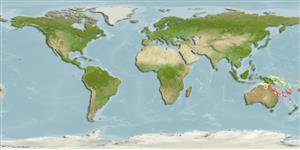>
Perciformes/Scorpaenoidei (Scorpionfishes) >
Bembridae (Deepwater flatheads)
Etymology: Bembras: Greek, bembras, -ados = a kind of anchovy (Ref. 45335); macrolepis: Named for its large body scales..
Environment: milieu / climate zone / depth range / distribution range
Ekologi
laut dasar (demersal); kisaran kedalaman 46 - 366 m (Ref. 27966). Tropical
Western Pacific: north of Townsville to off Wollongong, Australia.
Size / Weight / umur
Maturity: Lm ? range ? - ? cm
Max length : 27.3 cm SL jantan/; (Ref. 27966)
deskripsi pendek
Morfologi | Morfometrik
Duri punggung (Keseluruhan (total)): 11 - 12; duri punggung lunak (Keseluruhan (total)): 10-11; Sirip dubur lunak: 14 - 15. This species is characterized by the following: head depressed; body without large scute-like spines; infraorbital bones forming a strong ridge, confluent with uppermost preopercular spine and having 4-6 spines; broad subterminal vertical band in caudal fin (Ref. 40506).
Found on the continental slope. Benthic (Ref. 75154).
Life cycle and mating behavior
Kematangan | Reproduksi, perkembang biakan | Pemijahan | telur-telur | Fecundity | Larva
Imamura, H. and L.W. Knapp, 1998. Review of the genus Bembras Cuvier, 1929 (Scorpaeniformes: Bembridae) with description of three new species collected from Australia and Indonesia. Ichthyol. Res. 45(2):165-178. (Ref. 27966)
Status IUCN Red List (Ref. 130435)
ancaman kepada manusia
Harmless
penggunaan manusia
informasi lanjut
Nama-nama umumSinonim (persamaan)metabolismePemangsaEkotoksikologiReproduksi, perkembang biakanKematanganPemijahanSpawning aggregationFecunditytelur-telurpekembangan telor
Umur / SaizPertumbuhanpanjang-beratpanjang-panjangukuran frekuensiMorfometrikMorfologiLarvaDinamika larvapemulihanKelimpahanBRUVS
AcuanBudidaya airprofil budidaya airStrainGenetikaElectrophoresesDiturunkanPenyakit-penyakitPengolahanNutrientsMass conversion
mitraGambarStamps, Coins Misc.Suara-suaraCiguateraKecepatanTipe renangArea insangOtolithsOtakPenglihatan / visi
Alat, peralatan
laporan khas
muat turun XML
Sumber internet
Estimates based on models
Preferred temperature (Ref.
123201): 19.6 - 24.4, mean 21.7 °C (based on 30 cells).
Phylogenetic diversity index (Ref.
82804): PD
50 = 0.5332 [Uniqueness, from 0.5 = low to 2.0 = high].
Bayesian length-weight: a=0.00389 (0.00180 - 0.00842), b=3.12 (2.94 - 3.30), in cm total length, based on all LWR estimates for this body shape (Ref.
93245).
Trophic level (Ref.
69278): 3.7 ±0.5 se; based on size and trophs of closest relatives
Fishing Vulnerability (Ref.
59153): Low vulnerability (23 of 100).
